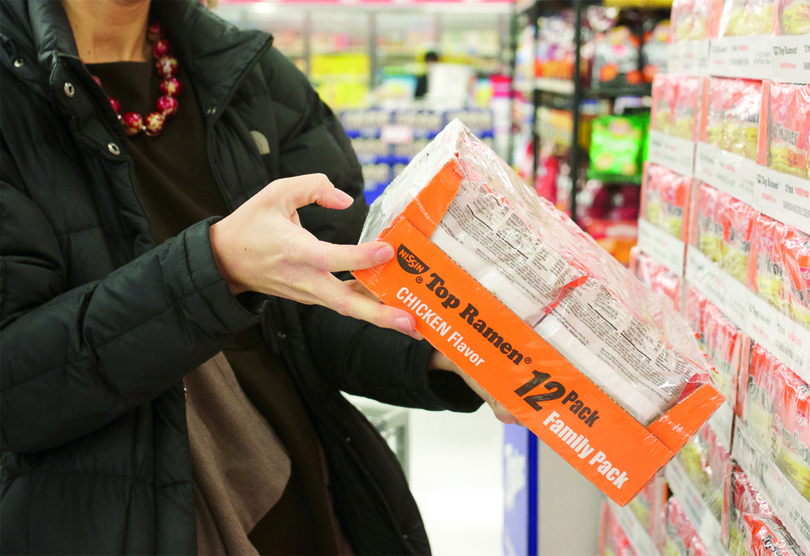Spread too thin: Hendricks dean reflects on week of living with food stamp restrictions
Tiffany Steinwert could only think about carrots on Saturday.
She had consumed foods like rice, beans, eggs and Maruchan Ramen noodles for six days, and her uncomfortably full stomach wanted nothing but the remnants of her limited vegetable supply.
Steinwert had $29.40, or $4.20 per day, to spend on a week’s worth of food, and the budget forced her to buy frozen foods and meals heavy in starch and salt rather than fresh produce. But Steinwert’s dilemma is all too familiar for low-income Americans that receive food aid under the Supplemental Nutrition Assistance Program, or SNAP.
“Because you don’t have a lot of money to purchase foods, you can’t really afford much variety,” Steinwert said.
Steinwert, the dean of Hendricks Chapel, took the 2014 Central New York SNAP Challenge from Feb. 9-15. During the weeklong event, which was organized by InterFaith Works of Central New York, participants attempt to maintain a healthy diet exclusively with SNAP food aid, otherwise known as food stamps.
Steinwert said she found purchasing healthy food under a budget difficult. As the federal government slashes food aid amid rising costs, the challenge aimed to raise empathy for and awareness of the SNAP recipients’ struggle to afford healthy options with a limited budget.
“Why is it that the poor are always at the center of budget cuts in America?” Steinwert said.
Purchasing healthy food proved difficult for Steinwert during last year’s SNAP Challenge, when she was given $34 to spend in a week. But a $5 billion cut in the federal program’s budget that went into effect Nov. 1 reduced her individual allotment even more, by nearly $5.
Congress recently passed an agriculture bill that will cut SNAP funding in 15 states, including New York, according to a Feb. 5 Washington Post article.
Food aid was increased by 14 percent as part of the federal stimulus in 2009, Sarah Hamersma, an assistant professor of public administration and international affairs in the Maxwell School of Citizenship and Public Affairs said in an email. When the increase was implemented, inflation was gradually supposed to even out costs.
But the stimulus and inflation never leveled out, and last year’s cuts marked a sharp 5 percent drop in funding, equivalent to a loss of $29 in weekly benefits for a family of three, she said. The cuts may have made the 37,880 Onondaga County residents that receive SNAP benefits more dependent on food pantries, Hamersma said.
As Steinwert showed solidarity with food stamp recipients, the combination of inflation and cuts made staying under this year’s SNAP Challenge budget more difficult, she said. The costs of basic items like chicken, cheese and margarine have risen since her previous SNAP challenge, Steinwert said.
But Maruchan Ramen noodles, which Steinwert described as “disgusting,” remained affordable at 20 cents per pack, she said.
Steinwert said the challenge didn’t leave her hungrier or more fatigued than usual. She ate portions similar to or even greater than those she normally eats.
Cheap foods with little nutritional value satiated Steinwert’s hunger longer than healthier foods in some cases, which poses a serious problem for those who regularly rely on the SNAP program.
“I think the misconception about SNAP benefits is that you’re not getting enough food and going hungry,” Steinwert said. “In reality you’re eating a lot of bad food.”
Those involved with the challenge also hoped to lessen an existing stigma around SNAP benefits, especially at a private university like SU, Steinwert said. She sees a degree of “poor shaming” around campus, she said.
Often, individuals that grew up in a household whose income was well above the level for SNAP qualification assume that those who receive benefits don’t work or even splurge on luxuries like lobster, she said.
But Steinwert remembers accompanying her grandmother to pick up her food stamps, back when the aid came in physical “stamps” rather than the current Electronic Benefit Transfer system. Though Steinwert’s parents didn’t receive aid, she would stand next to her grandmother, a woman who would take home scraps from the kitchen of a bar where she worked to make sure her family had enough food.
Steinwert recalls looking around at children her age waiting in line for stamps, wondering how they were any different than her.
Today, roughly half of children in Syracuse live below the poverty line, Steinwert said. And many of Syracuse’s children eat on a minimal budget, which she said concerns her after participating in two SNAP Challenges.
Steinwert said she believes continued cuts to benefits and a lack of empathy toward SNAP recipients should be addressed. But she also noticed the significant difference in price between healthy and “junk” foods.
Government policies like the recent agriculture bill can contribute to healthier foods costing more than junk foods, said Anne Bellows, a professor of food studies in the David B. Falk College of Sport and Human Dynamics. The food industry makes more money from chocolate, soda and pizza than fresh produce, she said.
Carrot growers have less pull in the United States government than corn syrup producers, she added.
“Most lobbying is for public expenditures to produce most cheaply the food that is the worst for our nutrition and health,” Bellows said.
Steinwert said she limits her 4-year-old son Grady’s intake of unhealthy foods. He enjoys treats like pizza or Oreos on certain occasions, but didn’t get to take any snacks into his school on Valentine’s Day because they cost too much for his mother’s SNAP Challenge budget.
Steinwert was happy to return to her regular food budget Monday as she bought Oreos for Grady and cream for her coffee, which she said she also couldn’t afford during her week on SNAP.
But after her experience with SNAP, Steinwert couldn’t help but think of other mothers who can afford only to buy “junk” for their children.
Said Steinwert: “When they’re thinking about how to fill the stomach of their children so they don’t say ‘Mommy, I’m hungry,’ they’re buying cheap junk food because that’s the best way to stretch their dollar.”
Published on February 18, 2014 at 3:19 am
Contact Jacob: jspramuk@syr.edu








